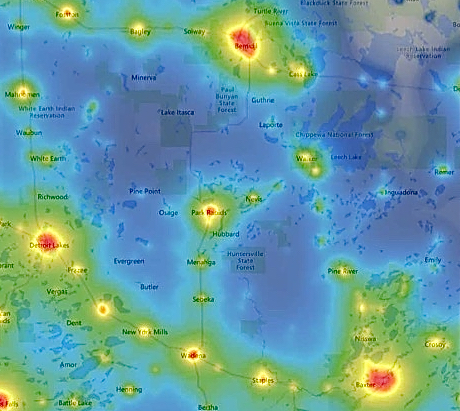Obituary of James Leland Wooters, who's favorite place on Earth
(and his most frequent destination), was Long Lake.
August 1, 1920 -
February 18, 2022 Born in Omaha, Nebraska
Resided in Urbandale, Iowa
James Leland Wooters, a devoted husband, family man and astute entrepreneur who touched countless lives with his enduring kindness, passed away peacefully Feb. 18, 2022, at his home in Urbandale, Iowa. He was 101.
Alongside his late wife, Mary, Jim was co-founder and president of The Fad of the Month Club/National Handcraft Society, a mail order business headquartered in Des Moines they grew into a national success. But it was his devotion to his family and his generosity to others, to whom he gave often and silently, that defined him.
Jim was born Aug. 1, 1920, in Omaha, Neb., to Hope and Leland Wooters. Along with his late brother, Richard “R.C.” Wooters, Jim was raised on Des Moines’ near north side, where he graduated from North High School in 1938.
While in high school, he met the love of his life, Mary Elizabeth Hagan, at an annual gathering of residents of Pine Haven Beach, a retreat for both families on the shores of Long Lake near Park Rapids, Minn. They were married in Des Moines on Sept. 13, 1941, and the two would remain side by side for 76 years until her death in 2018.
Jim studied at Drake University, where he was a member of Sigma Alpha Epsilon, before enlisting in the U.S. Army Air Corps in February 1943 during World War II. He served stateside as a radio navigation instructor until his discharge in February 1946.
Following his military service, he and Mary returned to Des Moines and started National Handcraft Society.
Jim was an ambitious leader with an endless supply of big ideas, often held in check by Mary, his ever-present voice of reason. Together, they formed a formidable business couple, with Jim lending his creativity and drive to create, market and deliver craft kits to households across the United States. He mined his voracious appetite for poetry and literature to pen a note with each Fad of the Month Club kit under the nom de plume “Nancy Lee, Club Secretary.”
Jim was a founding member of the Iowa Chapter of Young Presidents Organization (YPO), where he lent his considerable expertise to and forged lifelong friendships with other members of the organization, which focused on learning and the exchange of ideas in the business world.
Jim brought joy to everyone he met, with his curious mind, a contagious and immeasurable zest for life and a heart as big to match. He never refused a chance to dance with Mary. Nor could he resist delivering earnest recitations of poetry, including his incomparable retelling of "Casey at the Bat."
Jim also had a passion for worldwide travel and exploration, but his favorite place on Earth — and his most frequented destination — was Long Lake in Northern Minnesota, where he met Mary and spent much of his life fishing, playing golf and tennis with his family and friends.
It was there he developed in the early 1970s a family retreat he named Mirimichi, a getaway built out of love for his children and granddaughters, whom he doted upon. It’s a place that a sixth generation of family members still enjoys, much to his delight.
He is survived by son and daughter-in-law, Bob and Pat Wooters; daughter and son-in-law, Carol and Pete Click; five granddaughters and 13 great-grandchildren. Granddaughters and families are: Mary Puchalski, and sons Jake and Zach; Jennifer Olson, husband Mike, and children Walker, Mia and Owen; Heidi Ness, husband Lance, and children Henry, Greta and Camille; Christy McLaughlin, husband Mark, and children Ellie, Josie and Charlie; and Joey Frost, husband Peter, and children Anna and Oliver. Also close to his heart were his nieces, nephews and longtime friends and confidants.
Private family services will be held in the spring.
Memorials may be directed to: Long Lake Area Association Foundation, P.O. Box 808, Park Rapids, MN, 56470.


